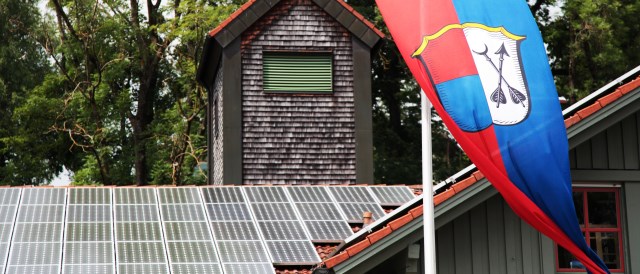Why does the Energiewende enjoy such widespread acceptance in Germany? Sara Peach went to Wildpoldsried and found that when citizens can invest in local renewable installations, everybody reaps the economic benefits of the energy transition.

Wildpoldsried lies in Bavaria, a German state about the size of West Virginia. The state has more installed photovoltaic capacity than the entire United States. (Photos: Sara Peach)
Renewable energy projects in the U.S. often face fierce citizen opposition — perhaps most famously, for example, that involving the Cape Wind project off the shore of Massachusetts.
But here in Wildpoldsried, a village of 2,615 inhabitants about 70 miles southwest of Munich, leaders have found a way to win citizen buy-in: let them invest in renewables projects themselves.
The village now generates five times more energy for electricity and heating than it needs. It does so from a mix of renewable sources, including solar, wind, hydroelectricity, geothermal, and biogas. Villagers sell the excess energy, enough to earn about €6 million ($7.8 million) a year. They have also reduced their carbon dioxide emissions by 125 percent.
The village’s rush for renewables began in 1998 when community leaders spent a weekend brainstorming goals for the future of Wildpoldsried, said deputy mayor Günter Mögele. But the goal to invest in renewables did not earn immediate and unanimous support from citizens.
“We are a totally normal village, and you always have opponents, especially when you start,” Mögele said.
Wildpoldsried is a conservative, tradition-oriented village in the German state of Bavaria, known for milk and cheese production. “Our church is still in the middle of the village,” Mögele said, referring to a German idiom.
But village leaders and activists won acceptance for renewables by pursuing small-scale projects owned by locals. Only citizens of Wildpoldsried are allowed to invest in the village’s wind turbines, despite interest from outside investors. So far, about 300 citizens have bought into the turbines.

The community is planning to build 10 new wind turbines in collaboration with neighboring villages.
Other renewable projects also lie in local hands. Thirty-seven percent of roofs in the village have solar panels, and local dairy farmers own the village’s biogas plants.
German law encourages people to generate renewable energy by giving individuals the right to feed power to the grid. Until recently, the law had guaranteed large subsidies to renewable generators.
Mögele said that without those subsidies, most of Wildpoldsried’s renewable projects would not have been financially feasible. But investment in renewables, he said, “makes the whole village a little bit richer.”

Thirty-seven percent of roofs in Wildpoldsried hold solar panels.
At the village gym, the sale of excess electricity from rooftop solar panels pays for the cost of building maintenance. Investment in the wind turbines, Mögele said, offers a higher rate of interest than banks.
Because of its success in renewable energy, the village now receives about 100 visiting groups each year from countries all over the world. The mayor of Fukushima, Japan, has visited twice.
“The participation of citizens — that, for me, is the secret,” Mögele said. “Whenever you have foreign investors or big companies, it’s not so easy. People will not accept it. Whenever they can participate by themselves, it’s much easier, and then they can take advantage, and after some years, well, they can also make some money.”
For additional information on the project, visit German Village Achieves Energy Independence…And Then Some.
This article by Sara Peach (@sarapeach) was first published by the Yale forum on Climate Change & the Media. It is published under a Creative Commons: Attribution-Noncommercial-No Derivative Works-License.